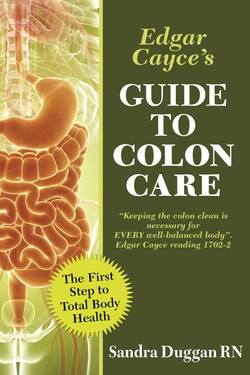Читать книгу Edgar Cayce's Guide to Colon Care - Sandra Duggan - Страница 25
На сайте Литреса книга снята с продажи.
ОглавлениеTHREE
Anatomy and Physiology
For as indicated ever, there is gradually a replenishing of every portion of the body, if the proper balance is kept in the system so that the eliminations and assimilations are such that each portion of the system may reproduce itself.
4061-1
The intestinal tract consists of the esophagus; stomach; small intestine, which is approximately 20-22 feet in length and 11½ inches in diameter; and the large intestine or colon, which is 4-5 feet long and 2½ inches in diameter.
Purpose of the Intestines
The small intestine originates at the pyloric end of the stomach and connects to the colon 20-22 feet later at the ileocecal valve. (See the diagram on page 24.) Its purpose is to digest and absorb food.
The first section, known as the duodenum, is where pancreatic digestive enzymes and bile mix with food. Peristaltic movements slowly move the chyme, or liquified food, along. Nutrients are absorbed into the bloodstream through five million finger-like projections and folds called villi, which line the walls. Cayce often speaks of the lacteals, the villi that absorb fats. The lacteals connect with the lymphatic system and empty into the return circulation to the heart.
The second section of the small intestine is the jejunum (6-12 feet long; 8 foot average), and the last section is the ileum (9-18 feet; 12 foot average). Nodules of lymph tissue called Peyer’s patches are found here, which contain lymphocytes whose purpose is to attack any bacteria that manage to survive coming into contact with the hydrochloric acid in the stomach. As we grow older, the hydrocholoric acid diminishes, and the villi and Peyer’s patches begin to atrophy, impairing the process of assimilation. So even though the diet may be in balance, the nutrients are not being absorbed properly. A series of castor oil packs (see Chapter 8) applied three to four times a year can help to maintain the health of the small and large intestine by stimulating the flow of lymph in these areas.
As chyme reaches the end of the ileum, it must then pass through a valve into the cecum (the first section of the colon). This ileocecal valve is normally closed, but opens as chyme reaches it. Any water from an enema or colonic does not go back through this valve into the small intestine if the valve is functioning properly.
The purpose of the colon, or large intestine, is to absorb electrolytes and excess water from the chyme and form a solid waste product. The friendly colon bacteria are able to manufacture vitamin K and some B vitamins, such as Bl2, riboflavin, and thiamine, in a healthy colon.
Sections of the Colon
CECUM
The cecum is a 2½-inch blind pouch that forms the first part of the colon. The appendix, a 3- to 6-inch long, finger-like pouch, extends from the cecum.
ASCENDING COLON
This section is wider near the cecum and narrows as it approaches a 90° bend called the hepatic (liver) flexure. Chyme must move slowly uphill against gravity, and then make a sharp turn. If eliminations are sluggish, the ascending colon can become very distended and congested.
TRANSVERSE COLON
This is the largest and most movable section of the colon. It makes another 90° bend on the person’s left side, called the splenic (spleen) flexure. It will sag or prolapse from the weight of solid matter remaining in the colon too long.
DESCENDING COLON
The colon then descends 5 to 6 inches before connecting to the sigmoid section.
SIGMOID
This is the narrowest part of the colon and is approximately 16 inches long. It is shaped like an “S” to prevent solid waste matter from emptying too quickly into the rectum.
RECTUM
This final part of the colon is approximately 12 inches long. It has an opening called the anus, which has two sphincters to help control the evacuation of stool.
Pockets
A smooth, mucous membrane lines the villi-free walls of the colon. A small amount of alkaline mucus is secreted from glands in the wall, protecting the delicate lining from too much acidity or abrasive waste matter. The colon has many pouches or pockets, called haustras, which contain layers of muscle that allow the colon to expand whenever necessary to accommodate varying amounts of solid matter. These muscles regularly make rhythmic contractions and relaxations called peristalsis, that slowly mix and move the bowel contents along.
Summary
1)The purpose of the colon is to absorb water from the liquid, digested food (chyme) and form a solid waste product. If the colon is healthy, bacteria will manufacture vitamin K and some B vitamins.
2)Villi line the walls of the small intestine and assimilate nutrients from the digested food.
3)The colon has no villi. It contains glands that secrete a small amount of mucus to protect the delicate membranes from too much acid and abrasive material.
4)The colon has smooth-shaped pockets called haustras that expand or contract during peristalsis to move the bowel contents along.
